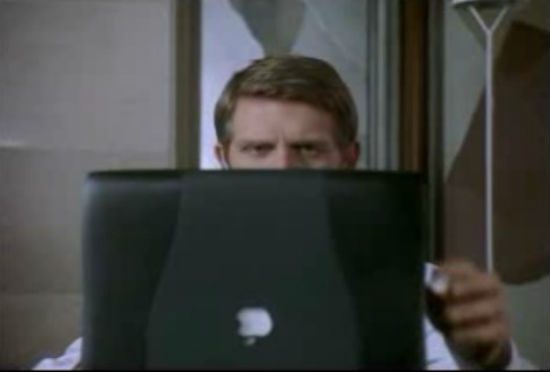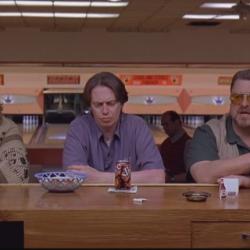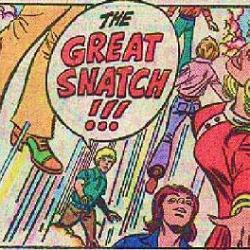Originally posted January 23, 2009.
You can read this entire series, for free, via the convenient Left Behind Index. This post is also part of the ebook collection The Anti-Christ Handbook: Volume 1, available on Amazon for just $2.99. My country is building prison camps for children. Volume 2 of The Anti-Christ Handbook, completing all the posts on the first Left Behind book, is also now available.
Left Behind: The Movie [2000] has conveniently been divided into 11 parts for posting on YouTube. This neatly provides us with stopping points as well as the ability to watch together as we work our way through the movie. Today we look at part 10 of 11. [Note: That 11-part bootleg is no longer on YouTube, but the entire 2000 movie is here. You can still watch along if you’re masochistic enough to want to do so.]
Check out the woman bandaging CamCam’s leg at the church. She isn’t introduced by name, but I’d recognize that crestfallen frumpiness anywhere. Hello again, Loretta.
I’m used to seeing more of that sort of thing in the movie adaptations of blockbuster best-sellers. The Harry Potter movies and Peter Jackson’s Lord of the Rings movies are filled with fleeting glimpses of characters from the page who had to be cut or condensed out of the films. Those little touches are a shout-out or a concession to the biggest fans of the books, those who are likely to be most demanding and most inevitably disappointed by the film adaptation.
Apart from this cameo by Loretta, there’s very little of this here in Left Behind: The Movie.This is partly due to the fact that the book was so poorly written. The characters and scenes that were cut for the adaptation weren’t vivid enough for anyone to complain about their absence. It’s also partly due to the nature of the fandom for this book series. Fans of the Harry Potter series loved to spend time in the world that J.K. Rowling had created, so they read and re-read her books, exploring every corner of every hallway of Hogwarts. The millions of readers of the Left Behind series, by contrast, were simply desperate for something, anything, they’d be allowed to read. They don’t care about the minor details and the minutiae of the world of these books, they’re just seeking validation for and by their subculture. So instead of cameos by otherwise absent but beloved minor characters, we get stunt casting, with Jack and Rexella, Bob Carlisle and Rebecca St. James.

“So you’re researching the disappearance of these people,” Rayford says to CamCam. He says it just like that, “these people” — not “my son,” or “our children,” just these people, as though this were an abstract puzzle to be considered dispassionately. “You say that you’re interested in finding out what really happened to them. Take a look at this, it might help.”
Rayford pops in the In Case of Rapture video and we see T.D. Jakes reciting 1 Thessalonians 4:16-17 and explaining that this describes the Rapture that has just taken place exactly as those verses describe. Well, except for the part about the Lord himself coming down from heaven with a shout. Or the part about the the voice of the archangel and the trumpet of God. Or the part about the dead in Christ rising first. But apart from everything in verse 16, actually, it’s exactly like what verse 17 describes.
Well, not exactly, but quite similar. Kind of. Almost.
Oh, and make sure you don’t read the rest of the chapter. Or the chapters before and after this one.
“Some guy thinks the Bible has an explanation for the vanishings?” CamCam asks, dismissively. “Come on, those scriptures are so vague, they could mean anything.”
Jakes/Billings only cited one passage, but CamCam says “scriptures,” plural, because his lines here have nothing to do with Buck Williams in a particular time and place responding to a particular biblical passage. His lines here, rather, are meant to represent the views of everyone in every time and every place who has ever failed to accept the particulars of Tim LaHaye’s brand of premillennial dispensationalism. In this specific situation, CamCam’s protest makes little sense. The scripture the pastor cites can’t mean just anything. I don’t think it can even be stretched to mean what the pastor says it means.
But Jakes did accurately describe the millions of children and babies disappearing, so the moment that follows here is somewhat effective. “Something else I should tell you,” Bruce Barnes says. “Pastor Billings vanished with the rest of them. I helped him make this tape three years ago.”
Gasp!
It’s odd that there’s no soundtrack, no score playing here. Based on the over-the-top scoring accompanying the earlier Big Moments, I’d have thought the filmmakers would have followed Bruce’s line there with something loudly redundant, possibly involving kettle drums. I’m guessing the lack of a score here has more to do with financial than artistic restraint.
This is the scene in the movie where a character is forced to suddenly confront and accept what kind of story they’re in. The more outlandish and fantastic the premise of the story, the more genre-resistance we can expect from the character. And this story is quite outlandish and fantastical.
But CamCam has already seen more than enough to convince him of the premise he’s facing here. By this point he really shouldn’t be this resistant to what he’s being told. The scene should be playing out more like this:
XANDER: Yep. Vampires are real. A lot of them live in Sunnydale. Willow will fill you in.
WILLOW: I know it’s hard to accept at first …
OZ: Actually, it explains a lot.
CamCam can protest all he wants that the prophecies Bruce starts rattling off don’t make any sense, but he should quickly realize here that the game is rigged, the story is what it is and whether or not it makes sense, he’s stuck with it.
As Nurse Loretta bandages his leg there at New Hope Village Church, CamCam has his laptop running through Dirk’s top-secret PowerPoint presentation. CamCam doesn’t seem to have realized that he’s putting their lives at risk. Nor has it yet occurred to him that the people who killed Dirk and Alan might be going after Ivy and her special friend next.
Bruce gets out his PMD Bible prophecy decoder ring and smugly explains that its tidy interpretations are both obvious and unquestionable. That Bushian smugness is the clearest sign yet that Bruce has really converted and become a real, true Christian. It is the hallmark of RTC-ism, the difference, I suppose, between knowing and believing.
The passages Bruce cites are nowhere near as tidy as he makes them out to be. Daniel chapter 7 is deliriously opaque, but clear enough that it can’t really be stretched to fit Bruce’s application. The consecutive reigns of 10 kings doesn’t seem like either a direct or a symbolic equivalent for 10 tracts of barren land. And read Ezekiel 38 for yourself and decide whether it’s really that close a fit for the flaccid nuclear assault we saw at the beginning of this movie.
For the most part, I’ve tried to avoid wading into exegesis and debates about the arcana of Tim LaHaye’s theology, but Bruce’s interpretation here of 2 Thessalonians 2 is so deeply weird and torturous that it bears a closer examination.
Bruce misquotes the passage — inserting the word “antichrist” where it cannot be found. But the weirdest thing here is his insistence that this passage is a prophecy about the rebuilding of the Temple. The passage says that the coming man of lawlessness “will oppose and will exalt himself over everything that is called God or is worshiped, so that he sets himself up in God’s temple, proclaiming himself to be God.” LaHaye and Bruce believe this was written by Paul sometime in the middle of the first century, yet they insist it is not a reference to the Roman emperor who, proclaiming himself to be God, destroyed Jerusalem and the Temple in 70 CE. Rather, LaHaye and Barnes suggest, this is a reference to an Antichrist from the distant future who will, 2,000 or more years later, rise to power and rebuild the Temple just so he can then destroy it all over again. LaHaye and Barnes thus also believe that Paul deliberately avoids mentioning the destruction of Jerusalem, withholding that useful bit of information from James and Barnabas and all of his other friends in that city. I guess he didn’t want to ruin their surprise.
The interpretation here, in other words, isn’t merely wrong. It’s warped and cruel.
But of course in the context of the fictional story being told in LBTM, it doesn’t really matter whether or not any of the biblical interpretation or theology makes any sense. In the context of this story, all this biblical gobbledygook is just phlebotinum and technobabble. It doesn’t have to make any more actual sense than all that stuff in Star Trek about dilithium crystals or tachyon pulses. It’s necessary here only to persuade the audience to suspend their disbelief enough to accept the parameters and premises of the story being told.
This explains quite a bit about the Left Behind franchise. At their core, these books and movies take a storytelling device designed to suspend disbelief within the bounds of the story and they try to use to to instill belief beyond the bounds of the story.
It also doesn’t help that Clarence Gilyard stumbles through the phlebotinum, at one point citing “Daniel 9, chapter 27.” That’s a pretty huge gaffe for this audience.
CamCam decides that all of this means he has to go back to New York to warn Chaim Rosenzweig not to share his magic formula with the Antichrist. Bruce could have advised him to stay to watch the rest of Billings’ video, which goes on to describe, in intricate detail, everything that is going to happen over the next seven years. But like St. Paul, Bruce decides to withhold the most useful information in his prophecies and instead just feebly tells Buck not to ignore God “tugging at his heart.”
CamCam limps off (limping on both legs, for good measure) cutting through the “emergency center” in the church’s sanctuary. The place is inexplicably crowded, as though an earthquake or tornado had just torn through Carol Stream. Who are these injured people? Buck was there because of a car bombing and because he can’t let the conspiracy catch him in a hospital. Were all of these people hurt in other car bombings? Are they all hiding from the conspiracy?
I’d guess that if we asked the filmmakers where these injured people came from, they’d answer that these were the people hurt in the post-Event accidents and crashes. But that was three days ago and we saw this same room a full 24 hours after the Event, completely empty except for Bruce and his paddle ball.
Back at the United Nations in Toronto, we have a study in quick and dirty set design. Say you have a scene with an official UN spokesperson, but you don’t know what the UN flag or seal looks like and you don’t have the budget to mock one up anyway. Not a problem. Just shoot your scene in the hallway or stairway of some municipal office that has its official seal on the wall, but shoot it all blurry so no one can see details. All those official seals pretty much look alike anyway.
Same thing with military uniforms.
Anyway, the spokesperson scene exists only to tell us that Nicole Carpathia has officially become the U.N. secretary-general. I thought that had already been established, but whatever.
CamCam is back at the UN — whether he flew there via Ken Ritz or the airlines are flying again we’re not told, although Stonagal and Cothran are there too, so we know at least that the super-rich are able to fly in from London.
CamCam’s headed to Chaim’s office when he gets stopped by Cadaverous Security Guy, but CSG is overruled by a suddenly authoritative-sounding Hattie Durham. I don’t know whether she’s supposed to come across as a brainwashed podperson or if this is just Mrs. C’s notion of a professional attitude, but in either case she ushers him in to see Rosenzweig.
Chaim Rosenzweig here stands as a surrogate for two things that don’t really go together. On the one hand, he represents the nation of Israel. On the other hand, he represents a naive, almost messianic, faith in the United Nations. What is it about the long history of Israel’s dealings with the U.N., one wonders, that leads the filmmakers to think their embodiment of Israeli nationalism should also be the embodiment of blind faith in the U.N.? This is vintage LaHaye-ism. He’s obsessed with both Israel and the United Nations, but he’s never allowed that obsession to cause him to actually learn anything at all about either of them apart from what he claims to know from “Bible prophecy.”
There is one thing in all of this for which the filmmakers deserve a bit of credit. Unlike the novel, LBTM makes Stonagal out to be a credible red herring. The movie consistently portrays him as the prime suspect for Antichristhood, consistently also portraying Nicolae as a naive idealist being unwittingly manipulated by this evil man. That pays off in the Big Finale much better than it does in the book.
But I’m getting ahead of myself. CamCam convinces Rosey of the Conspiracy’s plot to control the entire world’s food supply and they decide to take this information to Nicolae.
Jesus said that God, “maketh his sun to rise on the evil and on the good, and sendeth rain on the just and on the unjust.” And yea, verily, so too doth Steve Jobs maketh his products to be placed in the awful movies and in the good, and provideth laptops for the heroes and the villains alike. So the Antichrist is an Apple guy.
This may be my favorite piece of product placement ever.
Nicolae flares his nostrils and chews some scenery and tells Buck, “Do not worry. You are under my protection now.”
And CamCam — a globetrotting front-line journalist who, presumably, spent the past decade reporting from places like Sarajevo and Kigali — says, “Thank you,” secure in the knowledge that the United Nations secretary-general has promised to protect him.












